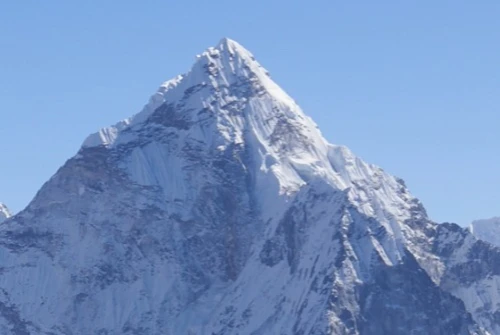Everest Three Passes Trek is Nepal’s most complete and adventurous high-altitude trekking circuit, combining the iconic Everest Base Camp Trek with scenic detours through Gokyo Valley, the turquoise Gokyo Lakes, and breathtaking viewpoints like Gokyo Ri and Kala Patthar. Tailored for experienced trekkers seeking the full Himalayan experience, this epic journey crosses three legendary mountain passes Renjo La (5,360 m), Cho La (5,420 m), and Kongma La (5,535 m) making it one of the most challenging and rewarding routes in the Everest region.
The trek begins with a short and scenic mountain flight from Kathmandu to Lukla, the traditional gateway to the Khumbu. From there, the trail leads through Phakding and gradually climbs to Namche Bazaar, the vibrant Sherpa town that serves as a cultural hub and acclimatization point. Departing from the classic Everest Base Camp route, the trail veers toward Thame and Lungden, leading to the spectacular Renjo La Pass, where sweeping panoramas of Mount Everest, Cho Oyu, and the shimmering Gokyo Lakes await.
In Gokyo Valley, trekkers ascend Gokyo Ri (5,357 m) for one of the best panoramic views in the Himalayas. The summit reveals sunrise vistas over Everest, Lhotse, Makalu, and Cho Oyu, with the massive Ngozumpa Glacier sprawling below Nepal's largest glacier.
From Gokyo, the trail continues over the icy and adventurous Cho La Pass, descending into the Khumbu Valley to merge back with the main Everest Base Camp route. After reaching Everest Base Camp (5,364 m) and witnessing awe-inspiring views from Kala Patthar (5,545 m), the journey turns toward the final challenge.
The toughest of the three, Kongma La Pass, leads to Chhukhung, unveiling remote high-altitude terrain adorned with glacial moraines, frozen lakes, and rugged Himalayan ridges. The descent continues through Tengboche Monastery, the spiritual center of the Khumbu, before returning to Namche Bazaar, Lukla, and finally Kathmandu.
This unforgettable trekking circuit is not just a hike it's a spiritual, cultural, and physical immersion into some of the most dramatic and diverse alpine landscapes in the world. Carefully planned with ample time for acclimatization, it offers a safe and deeply fulfilling Himalayan adventure.
Everest Three Passes Route
The Everest Three Pass Trek commences on the day after your arrival. It starts with a flight to Lukla, which offers breathtaking scenery, followed by a trek to Phakding, which involves crossing several suspension bridges. Subsequently, you proceed to Namche, entering Sagarmatha National Park, where you take time to acclimatize. During a rest day, you explore nearby villages and then trek to Tengboche to visit the renowned monastery.
As you ascend the trails, you make your way to Dingboche and then Chhukung for a second acclimatization phase. During this time, you hike through the hills and explore the Imja Valley. You cross the first high pass, Khogma-la, and continue to Lobuche the next day. From Lobuche, you ascend to Gorak Shep, where you have lunch and embark on a hike to Everest Base Camp. After spending some time at the base camp and descending to Gorak Shep, you trek to Kala Patthar for a sunrise view and then return to Lobuche the following day.
From Lobuche, your journey takes you to Zhonglha, and the next day, you head to Thangma, crossing the second high pass, Cho-La. Continuing the trek, you proceed to Gokyo and have your third acclimatization day. On this day, you explore the valley and visit the lakes. The following day, you cross the final pass, Renjo La, and descend to Marlung. From there, you hike back to Namche by descending the trail and then head to Lukla the next day. Finally, from Lukla, you take a flight back to Kathmandu, concluding your trekking adventure.
Everest Three Passes Difficulty
Everest Three Passes Trek is a challenging expedition due to the need to ascend to higher altitudes and navigate through some demanding mountain passes, including Renjo La Pass, Cho La Pass, and Kongma La Pass. These passes are among the most arduous and physically taxing segments of the entire Everest trek. Trekking to higher altitudes can pose difficulties in terms of breathing, as the oxygen levels diminish with elevation gain. Consequently, trekkers may experience symptoms of Acute Altitude Sickness.
The trek's level of difficulty is further compounded during the monsoon season when heavy rainfall can create muddy and slippery conditions along the route. It is essential to exercise caution with each step. Therefore, for beginners, it is advisable to avoid trekking in the monsoon season. However, experienced trekkers are likely to relish the challenges presented in any season. Similarly, during the winter months, the Everest region is blanketed in snow, which can make walking and traversing the trails considerably more challenging.
So, if you're an enthusiast and a fan of adventure, this is your time to experience the 20-day Everest Three Passes Trek with All Nepal Hiking.
Ideal Time of Year to Trek the Everest Three Passes
When going on a hike, one must consider the season in which they are going. And when is the best time of year to trek the Everest Three Passes? All Nepal Hiking recommends booking this expedition during the spring and autumn seasons. Spring lasts from March through May by further dividing these seasons. Because of the milder temperatures, these are ideal hiking months. The flowers are in full bloom during this season, and the pathway is lined with petals and leaves.
Autumn is the second-best season, lasting from September through November. These months are distinguished by vivid clouds and a cool environment. In general, we advise against hiking to Everest Three Passes during the summer. If your journey to Nepal is booked during the summer, All Nepal Hiking would be happy to organize an appropriate Himalayan excursion to Everest Three High Passes.
In general, we advise against hiking to Everest Three Passes during the summer. If your journey to Nepal is booked during the summer, All Nepal Hiking would be happy to organize an appropriate Himalayan excursion to Everest Three High Passes.
Required Permit for Everest High Passes Trek
To embark on the Everest High Passes Trek in Nepal, you must obtain two necessary permits: the Khumbu Pasang Lhamu Rural Municipality Entrance Permit and the Sagarmatha National Park Entry Permit. These permits are essential to access the trekking region and are typically included in your trip package.
Khumbu Pasang Lhamu Rural Municipality Entrance Permit:
- Where to obtain: Available in Lukla and at the National Park Entrance Gate in Monjo.
- Cost: NPR 2,000 per person.
Sagarmatha National Park Entry Permit:
- Where to obtain: Obtainable at the Nepal Tourism Board in Kathmandu and the National Park Entrance Gate in Monjo.
- Cost: NPR 3,000 per person.
Lukla Flight & Weather
Lukla is a small town situated in the Solukhumbu district of Nepal, at an elevation of 2,840 meters above sea level. There are three airlines that operate daily flights in favorable weather conditions. These are small twin-engine planes with a capacity of approximately 12 to 13 passengers. Flights usually depart early in the morning due to the unpredictable weather conditions that can develop in the afternoon.
It's important to note that flights to Lukla can frequently be canceled due to adverse weather, especially during peak seasons. In case your flight is canceled, you have the option to take a helicopter as an alternative. Helicopters can carry 4 or 5 passengers and cost between $350 to $500 per person.
Everest Three Passes Trek Accommodation
The Everest Three Pass Trek features a network of tourist-friendly tea houses with basic lodging facilities. Accommodations on this trek typically consist of twin-sharing rooms, although luxury suites can be found in lower regions for an additional cost.
Compared to other trekking routes, the accommodation services along this trail have advanced and improved over the years. Nowadays, they offer amenities such as comfortable mattresses, electric blankets, and hot showers, especially in lower regions. However, please be aware that lodging facilities become simpler and more basic as you ascend to higher altitudes. In these areas, you can expect wooden beds with firmer mattresses, pillows, and blankets.
Meals in Everest Three Passes
During the Everest Three Pass Trek, we provide a welcome or farewell dinner in Kathmandu and offer three meals a day (breakfast, lunch, and dinner) throughout the trek. You have the flexibility to choose your meals from a wide range of options. The menu includes traditional Nepali dishes like dal-bhat, soups, snacks, momos, and fried rice, as well as Chinese and continental cuisine such as noodles, spaghetti, spring rolls, and steak. Breakfast and dinner are typically served at the lodge where you spend the night, while lunch is enjoyed en route to your destination.
Recommended Preparation for Everest Three Pass Trek:
Undertaking the Everest Three High Passes Trek requires a high level of physical fitness and stamina. It is advised to start preparing for the trek at least 2-3 months beforehand. Here are some suggested preparations:
- Physical Conditioning: The Everest Three High Passes Trek is physically demanding, so it's essential to improve your fitness and endurance. Begin with regular cardio exercises like running, cycling, or swimming.
- Strength Training: Incorporate strength exercises like squats, lunges, and leg presses to build leg muscles and overall strength.
- Altitude Training: To acclimate to high altitudes, practice stair climbing, hiking, or trekking on nearby hills or mountains.
- Mental Preparation: Mental strength is vital for this challenging trek. Be mentally prepared for the journey, stay positive, and maintain determination throughout.
- Research: Conduct thorough research on the trek, its challenges, and the local culture to set realistic expectations and avoid culture shock.
- Meditation: Meditate to calm your mind and enhance mental resilience. Gradually increase the duration and frequency of your meditation sessions.
- Positive Attitude: Maintain a positive attitude to overcome obstacles and fully enjoy the breathtaking scenery and experiences along the trek. Focus on the journey rather than dwelling on the difficulties.
Everest Three Pass Trek is a hard and exhilarating trek through the gorgeous scenery of Nepal's Everest area. The trek is well-known for its stunning mountain views, varied terrain, and the opportunity to cross three high mountain passes. The journey begins in Lukla and follows the renowned Everest Base Camp path until it reaches Namche Bazaar, a bustling Sherpa settlement. The journey then continues to the first mountain, Kongma La Mountain (5,535 meters). This pass provides breathtaking views of the surrounding peaks, including Everest, Lhotse, and Makalu.
After crossing Kongma La, the trip continues to the renowned Everest Base Camp (5,364 meters), where you may witness the world's tallest mountain up close. The route subsequently ascends to the second pass, the Cho La Pass (5,420 meters), which offers a spectacular and difficult mountain passage. The trail then dips into the lovely Gokyo Valley, where turquoise lakes and the magnificent Gokyo Ri (5,357 meters) await. The ascent to Gokyo Ri rewards climbers with panoramic vistas of the Everest and Cho Oyu mountains, among others.
Finally, the trek continues on to the third and last pass, the Renjo La Pass (5,388 meters). This pass provides breathtaking views of the Himalayan giants like as Everest, Cho Oyu, and Nuptse. The descent from Renjo La takes you to Thame, a traditional Sherpa village noted for its rich cultural legacy.
Throughout the journey, you'll have the chance to learn about Sherpa culture, see old monasteries, and enjoy the warm hospitality of the locals. The Everest Three Pass Trek is an amazing experience for trekkers seeking adventure in the heart of the Himalayas. It includes spectacular landscapes, physical obstacles, and cultural contacts.

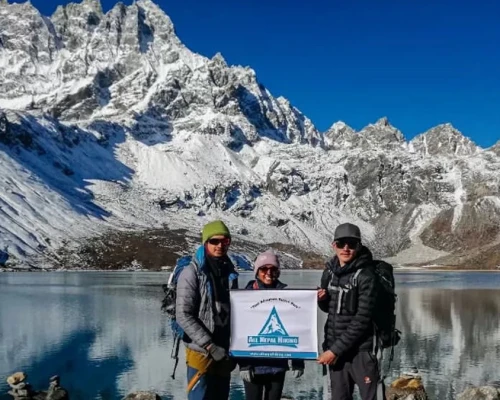
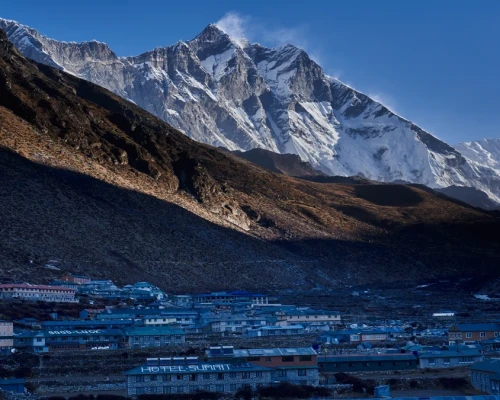
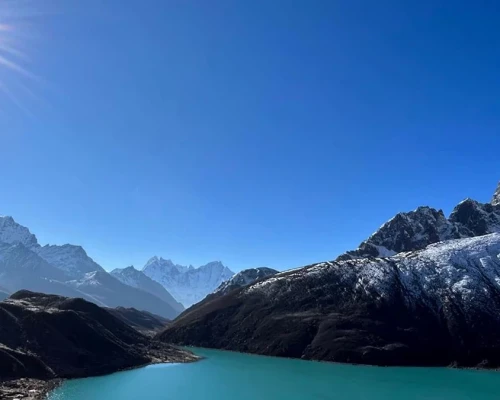
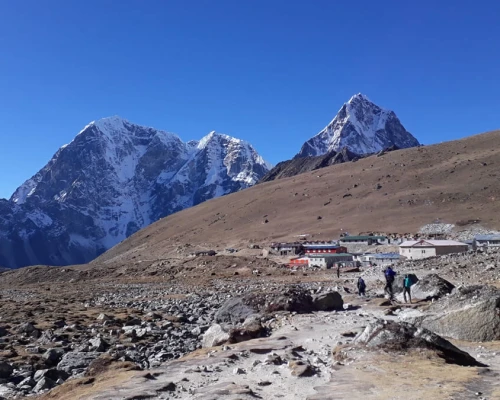

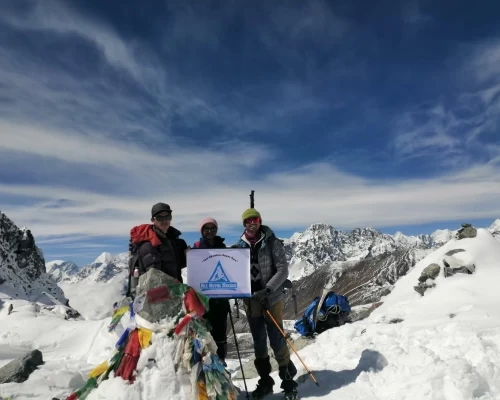
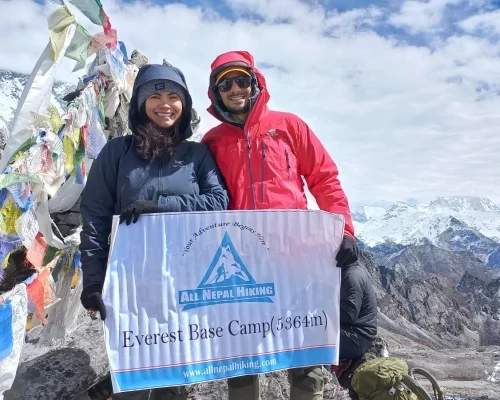
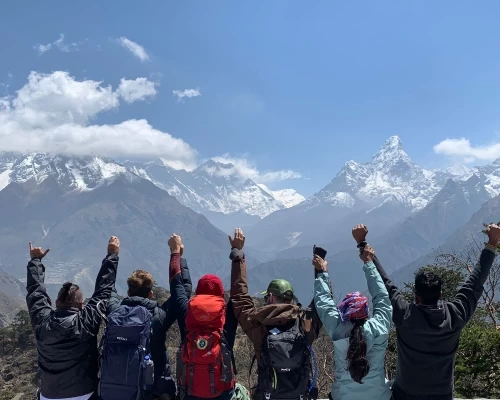

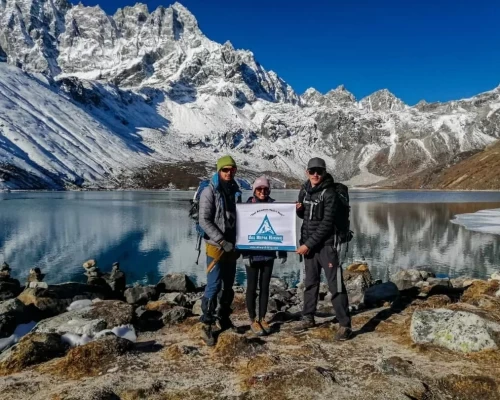



 based on 9 reviews
based on 9 reviews
